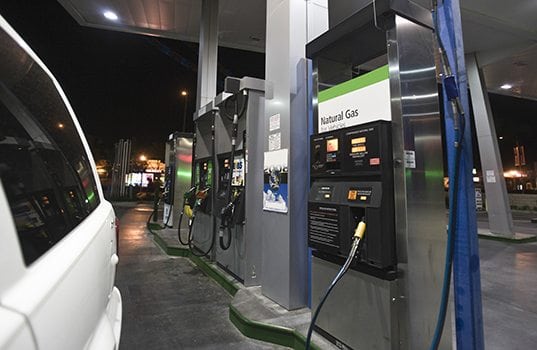A new report from Navigant Research analyzes the market for natural gas refueling infrastructure and the factors expected to influence its deployment, including global market forecasts segmented by fuel type, station type, and region, through 2025.
Due to its abundant supply, low price, and ability to reduce operating costs, natural gas is an increasingly appealing alternative for fueling ground vehicles. As fuel economy and greenhouse gas emissions standards become increasingly stringent in world markets—particularly for medium and heavy duty vehicles, where electrification is less practical—the use of natural gas is also an effective way to reduce carbon emissions. Click to tweet: According to a new report from Navigant Research, the total number of global natural gas refueling stations is expected to grow from 23,001 in 2015 to 38,887 in 2025.
“In the arena of alternative fuels for transportation, natural gas has proven to be one of the most popular alternatives to traditional liquid fuels in many global markets, either in the form of compressed natural gas (CNG) or liquefied natural gas (LNG), with the former being by far the more common,” says Sam Abuelsamid, senior research analyst with Navigant Research. “However, in order for any alternative to gasoline or diesel to be viable as a transportation fuel, readily available refueling infrastructure is an absolutely necessary component of the ecosystem.”
Despite the advantages of natural gas, the density of global refueling infrastructure varies widely and is often tied to government incentive programs, according to the report. In addition, without a critical mass of vehicles in need of fuel, station operators are unwilling to invest in equipment, and without ready access to stations, retail customers will not buy natural gas vehicles.
The report, Natural Gas Vehicle Refueling Infrastructure, examines the key factors expected to influence the deployment of NG refueling infrastructure, including economic growth, fuel prices, NGV sales, equipment costs, and regulations. The study provides an analysis of how all of these factors are projected to affect station operators, equipment suppliers, and gas suppliers. Global market forecasts, segmented by fuel (CNG and LNG), type of station (private vs. public), and region, extend through 2025. The report also examines the significant technical issues related to NG refueling infrastructure, as well as the competitive landscape. An Executive Summary of the report is available for free download on the Navigant Research website.








